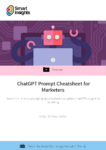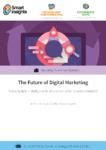Try these 8 new and trending customer-centric approaches to help you keep proving your value to leads and customers over email
Marketing trends forecasts should be resources marketers can consult to help them set strategic priorities for the coming year. But all too often they recycle the same old ideas or serve as thinly disguised showcases for vendor specialties.
So let’s make this email marketing forecast more useful by focusing on one overarching development we see happening in the world of email marketing and the supporting events that make it a significant development.
For my part, I expect that email experience will be the defining trend for 2024 – the increasing focus on improving our customers’ experiences with our brands, products, services, representatives, and messages.
Many of the more specific trends included in forecasts that are beginning to trickle in revolve around improving our customers' experiences of our emails. That includes everything from building up trust in the inbox to investigating Dark Mode email designs.
This rise in the customer experience as a major focus of marketing efforts goes hand in hand with greater attention being paid to customer loyalty. A study by SimplicityDX found the cost of acquiring new customers skyrocketed 222% since 2013, from $9 per customer to $29 in 2022. “Customer acquisition costs and higher rates of product returns account for virtually all of the difference,” the study claimed.
Two supporting trends contribute to this greater focus on customer experience: tools that help marketers work smarter, and practices that help companies become more customer-centric by putting customer and their needs, wants, and preferences first in all decision-making.
The eight trends listed below fall into one of these two categories, but they all contribute to a better CX and help the company continue to prove its value to its current customers.
This more focused attention on the customer experience can lead marketers to seek out and use tools and data that allow them to work smarter at the intersection of loyalty and business growth: helping customers achieve their goals makes the company more valuable to them and more worthy of loyalty.
1. The trend toward working smarter
When they work smarter, companies can serve customers better – everything from better products to more efficient browsing and buying in-store or online, customer support and services, more relevant and effective messaging, and even better deliverability to inboxes.
A. More brands aim for inbox visibility through trust and authentication
We have always advised our clients to create an informative inbox presence with both a quickly identifiable sender name (never a “no-reply” email address) and a strong subject line.
But now marketers must do even more to prove to mailbox providers and subscribers alike that their emails are inbox-worthy. Fortunately for email marketers, they have more tools today to get their emails into more inboxes and to help subscribers trust the messages enough to open and act on them.
These include BIMI {Brand Indicators for Message Identification) and DMARC (Domain-based Message Authentication, Reporting and Conformance), an email authentication, policy, and reporting protocol.
Using BIMI to build trust: Email fraud is on the rise worldwide, as is the financial damage it can inflict on people and companies who fall prey to attack. More than 3.4 billion phishing emails are sent daily. The financial cost is severe, with an estimated cost of £150 ($181) for each piece of personal information stolen in a phishing attack.
Wary subscribers are more cautious about falling victim to email fraud, but they can also go to the opposite extreme and discard or report genuine emails as spam or fraud. BIMI is gaining more traction as a trust signal, thus creating a better customer experience.
BIMI is an email specification that standardizes logo display across mailbox providers. Because it requires the sender to verify that it is authorized to send email with that logo. It can also assure subscribers that a message is from an authentic sender and not someone spoofing the brand.
Brands that have passed the necessary requirements for verification can display their logo next to their email message in the inbox. Brands that haven’t gone through the process will continue to display no logo, as in Gmail, or a default image as in Yahoo! and Outlook among others.
The image below shows a mobile Yahoo! Mail inbox displaying messages both from brands that have gone through BIMI verification and those that have been assigned a default image, usually featuring letters pulled from the brand name.
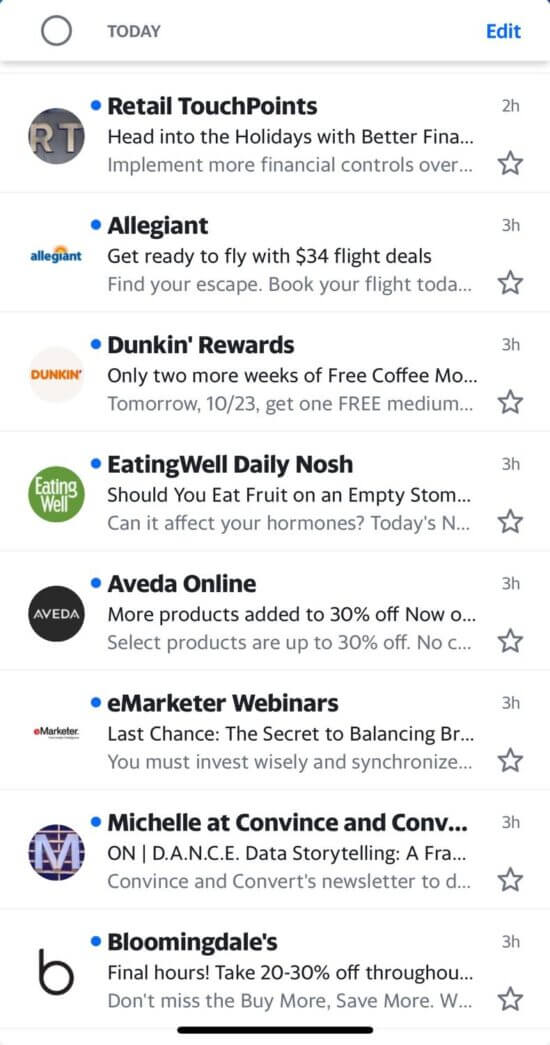
A brand must follow an authentication path specified by the AuthIndicators Working Group, an industry coalition of mailbox providers and email security firms. They must pass DMARC validation checks, among other requirements.
As of publication, Google/Gmail, Yahoo! Mail, Apple Mail, La Poste, Fastmail and Cloudmark support BIMI. Microsoft (Hotmail, Outlook) does not. Mailbox providers considering support include Yahoo! Japan, Comcast and BT.
DMARC validation becomes a must-do: While the customer experience impact isn’t as obvious here as it is with inbox trust signals, it does ensure that the emails people look forward to seeing in their inboxes will actually show up there.
In autumn 2023, both Google/Gmail and Yahoo! Mail announced plans to tighten sender requirements to place messages in their users’ inboxes. It’s no longer enough to show a subscriber gave active permission to send email.
Now senders must also authenticate their sender IP addresses and domains using SPF (Sender Policy Framework) and DKIM (Domain Keys Identified Mail) as well as DMARC with at least a p=none policy, which tells inbox providers to deliver email even if they fail SPF and DKIM checks.
However, many email security experts recommend senders set their DMARC policy to p=reject, which tells inbox providers to block any mail that fails SPF and DKIM checks.
Gmail and Yahoo! Mail also want email recipients to be able to unsubscribe from a brand’s emails with a single click, so they’re requiring brands to use list-unsubscribe headers. This code, which an ESP will add to the email header code, places a native unsubscribe link in the inbox’s message.
Placement varies between email clients. In Gmail, the unsubscribe is a text link next to the sender's name (top image). In Yahoo! Mail’s mobile app, it appears as a CTA button marked “Unsubscribe” at the bottom of the message (bottom image).

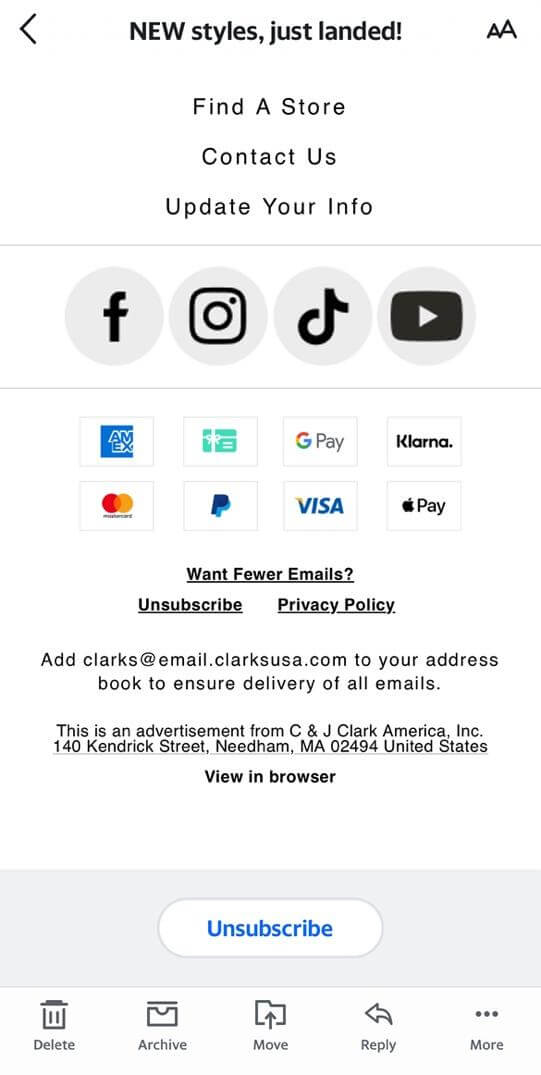
B. Marketers will expand their use of Generative AI
Generative AI, or “GenAI,” has evolved from the latest shiny toy to a genuine business asset in the space of just a couple of years. This adoption should increase in the next year and beyond as more marketers become familiar with AI-driven tools and learn how to use them successfully.
For marketers, much of the attention has swirled around OpenAI’s ChatGPT for copywriting and idea creation and optimization, and DALL-E for creating and optimizing images from text prompts and descriptions.
ChatGPT, which is built on OpenAI’s GPT large language model, is one of the fastest growing AI-driven language bots, with more than 100 million registered users since it launched in November 2022. A number of proprietary tools such as Jasper and WriteSonic have emerged, as well as free or low-cost tools like Bing from Microsoft and Google’s Bard.
As reported in Smart Insights’ The Future of Digital Marketing, about one-sixth of businesses have used AI for content creation and optimization for more than a year, with around one third recently starting using AI for generating content for SEO, social media, and email marketing.
The top three uses for AI in email marketing are content personalization, email retargeting, and subject line optimization, according to 2023 Email Marketing & Research Report: A Look at the Market for the Future of the Channel, a research report by RPE Origin and Ascend 2. Other uses include dynamic content creation, send-time optimization, predictive analytics for customer behaviour, automated segmentation and targeting, and A/B testing and optimization.
Use GenAI to write a campaign brief: The simplest ones are for generating short bursts of highly focused copy, such as headlines, subject lines, calls to action, taglines, email body copy, and the like. Some marketers have experimented with using ChatGPT and other copy-focused bots for producing long-form copy, but results have been mixed so far.
My agency has discovered that ChatGPT can shave a great deal of time off the process of creating a detailed brief for a complex email campaign.
Here’s a recent prompt I write for an email campaign brief in which we called on several persuasion principles developed by Robert Cialdini in his book, Influence: The Psychology of Persuasion. Note the precise instructions! I used ChatGPT to produce this brief, but the principle is the same no matter which GenAI tool you use: The copy is only as good as your prompt, or instructions.
“You’re an email marketer for an ecommerce clothing retailer tasked with writing compelling copy to increase conversions for an email campaign. You’re selling a new range of summer dresses that are affordable, pretty, comfortable and stylish.
Deliver one subject line, opening paragraph, and call to action, using each of the persuasion principles and cognitive biases listed below, without actually mentioning the cognitive bias within the copy, but label each example with the principle or bias:
Reciprocity, scarcity, social proof, authority, anchoring, loss aversions, curiosity gap, endowment effect, confirmation bias, emotional appeal.”
If you're looking to get started with ChatGPT, don't miss our new Free Members' ChatGPT prompt cheatsheet, which contains a fully integrated A-Z glossary of ChatGPT features and techniques, with tips and examples, plus our recommended free and paid tools including ChatGPT alternatives.
C. More use of complex email automations
One example is switching from a single system-generated email to a multi-email series of branded, optimised messages aimed to engage new subscribers and move them to act, such as creating an account or making a first purchase.
Although we have no recent data on the percentage of email marketers who have, for example, added a cart-abandonment series to their email programmes or expanded their welcome email into an onboarding series, I have seen wider acceptance of these automations among my clients and in the wider email marketing world.
Driving this trend are four recent developments:
- Cloud-based software-as-a-service platforms, including ESPs and start-up AI tech firms, with near-instantaneous integrations and dashboards that take much of the work out of building complex automations and email templates
- Development of tools that can automate the creation of different customer segments and optimize the timing and content of highly personalized emails based on data held about individual recipients
- Greater access to data, especially in real-time, without having to wait for database managers to answer requests
- Cutbacks in marketing team size, especially during and after the COVID-19 pandemic, which forced remaining marketers to look for efficiencies wherever they could find them.
The resulting do-it-yourself approach, which no longer needs the same degree of IT involvement, has made automation more accessible. On average, 81% of marketing organisations use some form of automation, according to Salesforce.
This means email marketers are getting more sophisticated about automation and their results, and companies are recognising that money spent on these more complex automations gets returned in the form of higher revenue and customer retention.
With automation, brands can collect and manage individual preferences automatically and call on those details to create more relevant and personalized communications. This helps brands meet customers’ expectations for receiving messages that they are interested in, thus improving the customer experience through email.
As more ESPs add automation features to remain competitive I expect to see more marketers begin to explore them and use them to save time and increase conversions and retention.
D. Better organising and access to data
A key part of the trend toward working smarter is improving marketers’ access to data and using the data we have more efficiently and effectively to inform decision-making – everything from campaign development and audience choice to content selection and message optimisation and analysis.
The CDP, or Customer Data Platform, is on the cusp of becoming a mainstream data entity. The CDP Institute estimated CDP industry revenue would reach $2.3 billion in 2023 – a modest growth over $2 billion forecast in 2022 and says there are 171 defined vendors in the CDP space.
A CDP has some overlap with a Customer Relationship Management (CRM) platform in that both are intended to manage and integrate data, but CDPs pull in and unify data from a larger range of sources to provide a complete view of the customer beyond the sales cycle.
A CDP promises both a better customer experience through more timely, personalised and relevant messages, and a “work smarter” advantage because it can reduce the labour that marketers put into creating, selecting or requesting audiences or segments, building multiple versions of email campaigns to match those audiences and sending all of those campaigns out at once.
I expect more brands will explore CDPs, but while they will appreciate the unified customer views that are a hallmark of the CDP, they will also discover that CDPs need to be able to access that data from siloed sources, such as customer support contacts. CDPs also require a lot of data to be most effective. Other tools, such as CRM platforms, might be able to meet a company’s needs if it doesn’t generate the kind of data, or enough data, to make a CDP worth the cost.
E. Using AI to support A/B split testing
A/B split testing will become more commonplace thanks to two developments:
- More testing tools provided as features on email sending platforms
- Using generative AI to create test controls and variations faster and more accurately
As the RPE Origin/Ascend2 study cited in a previous indicated, many enterprise-level email marketers use ChatGPT and other large-language model bots to take some of the drudge work out of doing A/B split testing.
The simplest ways are to use these language bots to suggest alternatives for subject lines, calls to action, or copy blocks that that range from the prosaic (word or character count, word choice, sentence structure) based on a hypothesis, to more sophisticated variations based on emotional approach, or persuasion elements or selecting testing audiences.
Start improving your use of of ChatGPT today when you join us as a Free Member to access our ChatGPT prompt cheatsheet, which contains a fully integrated A-Z glossary of ChatGPT features and techniques, with tips and examples, plus our recommended free and paid tools including ChatGPT alternatives.
2. The trend to focus on customer-centricity
We are still feeling the reverberations of the shifts in email messaging driven by the COVID-19 pandemic, primarily in retooling email programmes to meet customer needs and wants first over driving company objectives.
Although this customer-first trend has receded somewhat as society moves into post-pandemic mode, I still see brand email teams retaining or even expanding on efforts to make email as customer-centric as possible through these three trends:
A. Dark mode email design
Dark mode aims to give electronics users a bit of a break from the brilliantly lighted screens that render graphics so well and is often part of the movement to building greater accessibility into email viewing to overcome challenges for readers with vision or cognitive issues.
Although no recent reliable statistics point to the percentage of users who choose view email and other interfaces in dark mode, an investigation by Litmus found 40% of iPhones have the feature enabled.
A study by the Nielsen/Norman Group also found no single preference for one polarity over another. About one-third of respondents chose dark mode, another third used light mode exclusively, and the remaining third used both.
Dark mode can pose a problem for marketers because designs that are optimized for light mode don’t always render correctly in dark mode. Rendering can vary across different email clients as well. As one example, colours can render differently against a darker background, often becoming nearly invisible.
Designing one template for a dark mode version of an email template can be virtually impossible given how it can render across so many email clients. Rather, determine which email clients most subscribers use and create a template design that renders well across it.
B. AMP for Email – not dead yet!
Originally promising to increase interactivity in email and allow conversions to happen in the message instead of on a landing page, AMP for Email is still waiting for its close-up in email design circles.
However, some brands haven’t given up on this technology, which promised to eliminate one step in the path to conversion – the need to leave the inbox and complete the action on the website. This leads me to believe that AMP for Email could trend again, especially if marketers and email developers discover it can fill a need despite its drawbacks.
AMP has fallen short of the mark for a number of reasons:
- Microsoft cancelled its AMP for Email pilot for Outlook, and Google has de-emphasised it.
- Only a few ESPs and mailbox providers support the technology.
- Brands pulled back from adding experimental technology during the pandemic and subsequent global recession.
However, AMP for Email could be poised for a breakthrough because it has support from two major mailbox providers (Gmail and Yahoo! Mail) and two ESPs (MessageBird and Netcore Cloud).
Netcore has developed several case studies supporting AMP for Email, including one for YourStory, the content and communications platform dedicated to India's start-up economy.
Your Story had three goals: to increase participation in its events, to grow the number of leads from those events, and to streamline its event registration process.
Working with Netcore's Customer Success Team, YourStory transformed its traditional email marketing programme by using AMP for Email and introducing AMP-based responses and registrations in its email messages.
The process had two advantages over sending traditional emails that required users to click to a landing page to register for an event:
- Simplified registration: Users could share their information within the email in a matter of seconds and on the fly.
- Fewer lost registrants: Because registrants could complete registrations in the email message, this reduced drop-offs.
According to YourStory’s Aaron Karthik, head of digital marketing, the AMP for Email test generated a 5.5X increase in conversions for event registrations.
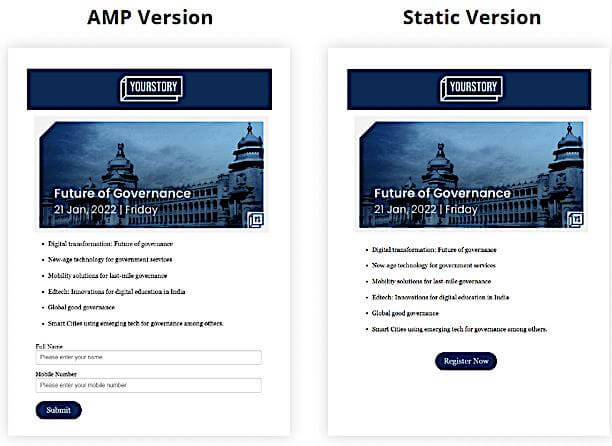
A B2C example of using interactive email to achieve a business end comes from snacks retailer Feastables, which uses AMP for Email in a select group of emails. Below is an example of using the format to draw subscribers into a content built around a trivia quiz.
Respondents could answer quiz questions without leaving the email (image at left). If they clicked an incorrect answer (center image), they got an error message but could refresh the email and try again (image at right).
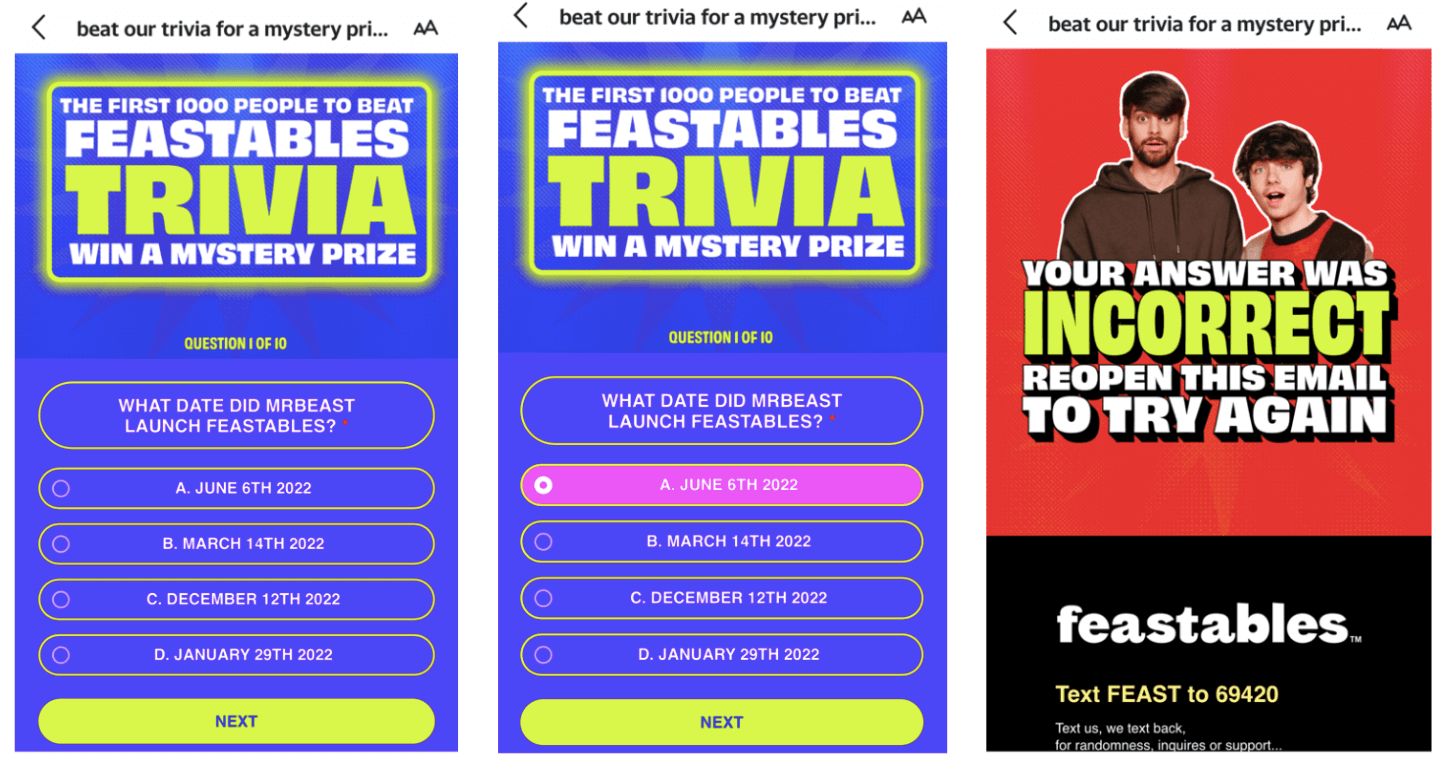
C. AI in personalization for higher sales and customer engagement
Along with my general prediction that companies will find more uses for AI in email marketing, I also believe they will find uses that align more closely with strategic objectives instead of limiting themselves to subject-line or call-to-action drafts.
As an example, AI can help personalize the email newsletter – the workhorse of an email content strategy. All too often they are static affairs driven more by what a brand wants to tell its customers than by customers’ highly individual interests. AI can help transform them into more relevant messages, as the report below from Volvo indicates.
Creating a personalized newsletter at scale is an ongoing challenge for many brands. But Volvo used its vast quantities of customer data to build profiles and elevate its CRM function. Tony Allen, Global CRM Lead for Volvo cars, explained to me that Volvo needed to design customer communications that kept them interested in Volvo during the typically extended automobile purchase cycle.
Volvo wanted to communicate more often with engaged segments, send hyper-targeted, relevant campaigns and personalize campaigns that had a single focus. The process included these steps:
- Machine learning platform iota-ML, AI-copywriting tool Jasper.ai, and video-in-email system Playable were chosen to deliver this upgraded customer experience.
- The team tested a weekly version of its bi-monthly newsletter on 10% of its audience for 12 weeks.
- After learning that the test audience responded well to the new format, the company rolled it out to the rest of its audience.
- The revamped newsletter featured content in two categories: “help and inform” or “inspire and entertain.” Volvo’s CRM team used cross-functional planning to pull timely content.
- The email clickstream was classified into 28 customer content preference categories The Iota-ML platform used these 28 categories to build predictive audiences to personalise and engage small segments.
- Volvo sent 75 predictive campaigns in the first year, positioned as “We thought you’d like this.” This campaign format was effective among groups with lower general engagement.
Results: Using machine learning via Iota-ML streamlined data usage for content choices and reduced the campaign process to two hours from idea to campaign deployment. It also resulted in the following:
- 3X increase in year-over-year engagement
- 47% of new product sales came from ML audiences
- The “most engaged subscribers” segment grew 4.5X
- The highly engaged segment interested in electric-car content grew 6X
- Volvo used a universal control group, which meant the company could tie the impact of the change directly to higher revenue
The trend of embracing MarTech developments amongst email marketeers
I‘ll be the first to admit that my trends list for 2024 involves some wishful thinking. But I’ve also seen a greater openness to the advantages of using data, technology, and good old-fashioned strategic thinking to keep email going as a way to give customers a better experience with a brand, one that helps them achieve their own goals – which, in turn, help companies achieve theirs. I’m excited to see how this next year plays out!
For more help identifying and prioritizing digital marketing trends to inform your strategy, don't miss the 2024 edition of The Future of Digital Marketing, exclusively for Smart Insights Free Members only.
Download our Free Resource – The Future of Digital Marketing trends report
Download our future of digital marketing report to benchmark your marketing across the 7 pillars of digital marketing and 400+ marketers.
Access the Future of Digital Marketing 2025 trends report






